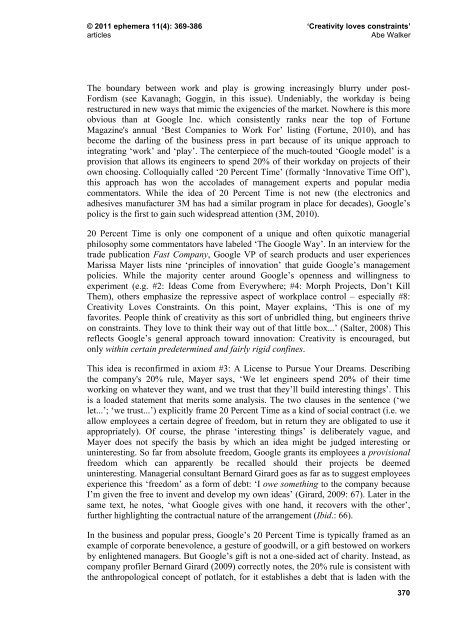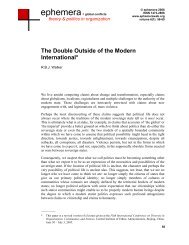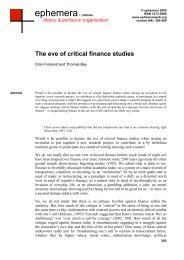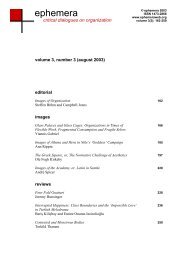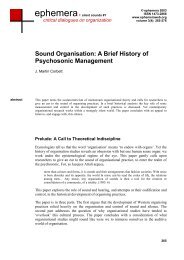Work, play and boredom - Ephemera
Work, play and boredom - Ephemera
Work, play and boredom - Ephemera
You also want an ePaper? Increase the reach of your titles
YUMPU automatically turns print PDFs into web optimized ePapers that Google loves.
© 2011 ephemera 11(4): 369-386 ‘Creativity loves constraints’<br />
articles Abe Walker<br />
The boundary between work <strong>and</strong> <strong>play</strong> is growing increasingly blurry under post-<br />
Fordism (see Kavanagh; Goggin, in this issue). Undeniably, the workday is being<br />
restructured in new ways that mimic the exigencies of the market. Nowhere is this more<br />
obvious than at Google Inc. which consistently ranks near the top of Fortune<br />
Magazine's annual ‘Best Companies to <strong>Work</strong> For’ listing (Fortune, 2010), <strong>and</strong> has<br />
become the darling of the business press in part because of its unique approach to<br />
integrating ‘work’ <strong>and</strong> ‘<strong>play</strong>’. The centerpiece of the much-touted ‘Google model’ is a<br />
provision that allows its engineers to spend 20% of their workday on projects of their<br />
own choosing. Colloquially called ‘20 Percent Time’ (formally ‘Innovative Time Off’),<br />
this approach has won the accolades of management experts <strong>and</strong> popular media<br />
commentators. While the idea of 20 Percent Time is not new (the electronics <strong>and</strong><br />
adhesives manufacturer 3M has had a similar program in place for decades), Google’s<br />
policy is the first to gain such widespread attention (3M, 2010).<br />
20 Percent Time is only one component of a unique <strong>and</strong> often quixotic managerial<br />
philosophy some commentators have labeled ‘The Google Way’. In an interview for the<br />
trade publication Fast Company, Google VP of search products <strong>and</strong> user experiences<br />
Marissa Mayer lists nine ‘principles of innovation’ that guide Google’s management<br />
policies. While the majority center around Google’s openness <strong>and</strong> willingness to<br />
experiment (e.g. #2: Ideas Come from Everywhere; #4: Morph Projects, Don’t Kill<br />
Them), others emphasize the repressive aspect of workplace control – especially #8:<br />
Creativity Loves Constraints. On this point, Mayer explains, ‘This is one of my<br />
favorites. People think of creativity as this sort of unbridled thing, but engineers thrive<br />
on constraints. They love to think their way out of that little box...’ (Salter, 2008) This<br />
reflects Google’s general approach toward innovation: Creativity is encouraged, but<br />
only within certain predetermined <strong>and</strong> fairly rigid confines.<br />
This idea is reconfirmed in axiom #3: A License to Pursue Your Dreams. Describing<br />
the company's 20% rule, Mayer says, ‘We let engineers spend 20% of their time<br />
working on whatever they want, <strong>and</strong> we trust that they’ll build interesting things’. This<br />
is a loaded statement that merits some analysis. The two clauses in the sentence (‘we<br />
let...’; ‘we trust...’) explicitly frame 20 Percent Time as a kind of social contract (i.e. we<br />
allow employees a certain degree of freedom, but in return they are obligated to use it<br />
appropriately). Of course, the phrase ‘interesting things’ is deliberately vague, <strong>and</strong><br />
Mayer does not specify the basis by which an idea might be judged interesting or<br />
uninteresting. So far from absolute freedom, Google grants its employees a provisional<br />
freedom which can apparently be recalled should their projects be deemed<br />
uninteresting. Managerial consultant Bernard Girard goes as far as to suggest employees<br />
experience this ‘freedom’ as a form of debt: ‘I owe something to the company because<br />
I’m given the free to invent <strong>and</strong> develop my own ideas’ (Girard, 2009: 67). Later in the<br />
same text, he notes, ‘what Google gives with one h<strong>and</strong>, it recovers with the other’,<br />
further highlighting the contractual nature of the arrangement (Ibid.: 66).<br />
In the business <strong>and</strong> popular press, Google’s 20 Percent Time is typically framed as an<br />
example of corporate benevolence, a gesture of goodwill, or a gift bestowed on workers<br />
by enlightened managers. But Google’s gift is not a one-sided act of charity. Instead, as<br />
company profiler Bernard Girard (2009) correctly notes, the 20% rule is consistent with<br />
the anthropological concept of potlatch, for it establishes a debt that is laden with the<br />
370


